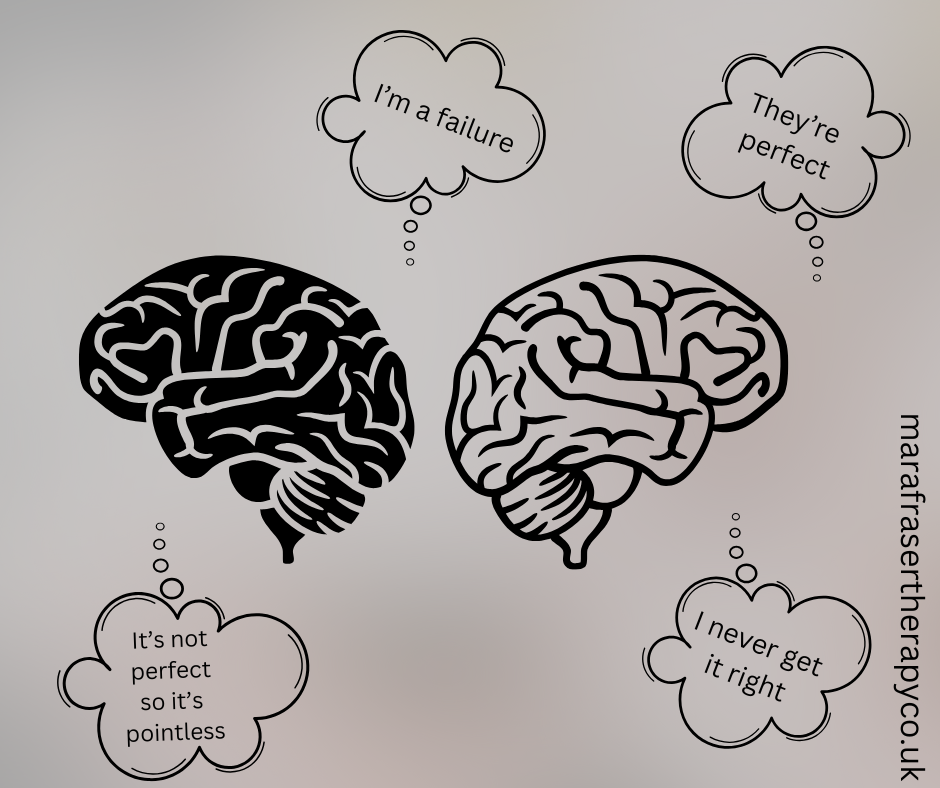Understanding Black and White Thinking
Why it happens and how to break free
Black and white thinking, also known as all-or-nothing thinking, is one of the most common forms of negative thinking patterns. It often arrives in the therapy room at some point. In reality, life is not easily pigeonholed into ‘good’ or ‘bad’, yet it is often the case that we try to place events, people and ourselves into one or the other of these slots.
What is black and white thinking?
In psychological terms black and white thinking is known as a cognitive distortion. It warps our thinking so we slot everything into a good vs bad catergory. This leaves little room for nuance which is problematic because, in real life, most things exist in the gray area between the two.
Maybe you recognise some of these thoughts:
I am a total failure
They are perfect
If I can’t to this perfectly, it’s pointless
I can never do anything right
While common, this type of thinking takes a real toll on our personal relationships and our overall mental well-being. Often this leads to misinterpretation of events.
Common misinterpretations because of all-or-nothing thinking include:
You get good feedback at work, but you focus on one point that leads to the conclusion that you are dreadful at your job and about to get fired.
Your friend has to cancel some plans, and you assume it is because of something you said, or did or that they don’t care about you at all.
You spend hours (often when trying to sleep) ruminating about past mistakes that ‘prove’ you are unworthy or bad.
These types of thoughts often develop as a coping strategy. As human beings, we find it a lot easier to deal with things if they fall into clear categories. However, over time, it can become damaging and lead to constant self-criticism, eventually limiting us in our work, social life, and relationships.
Why is Black and White Thinking Harmful?
It takes a huge toll on our emotions if we live in extremes, swinging from pole to pole. One minute all is fantastic, we are great, everyone is fabulous; the next, it is the opposite it’s a rollercoaster ride.
All-or-nothing thinking impacts us in a lot of different ways:
Reduces self-esteem: If the only way to see success is through perfection, you will often feel like a failure.
Strains relationships: Seeing people as either completely good or totally bad can lead to conflict. Unrealistic expectations of others often lead to disappointment in relationships.
Fuels anxiety & depression: These thought patterns can act to increase feelings of pressure, powerlessness and hopelessness.
Blocks your personal growth: mistakes are essential to learn and grow. Black and white thinking sees them as failures and often causes people to give up. This, in turn, means missing out on real opportunities to progress as a person in our work or personal lives.
How to Move Beyond Black and White Thinking
Challenging black-and-white thinking takes time and commitment. You are working to rewire your brain to move away from pathways that are familiar and comfortable and into new territory. This doesn’t mean learning to ignore difficulties and challenges. The aim is to view situations and people with much greater balance and compassion. You will notice that, after a while, you will start to spend more time in the grey areas where things will feel more balanced, calmer and realistic.
Here are some steps to try:
Be curious about yourself: start to notice the patterns that emerge. As you do so, you will become aware of those extreme words: never, always, failure, and perfect. This is the first step to making a change.
Question yourself: Is there a middle ground here? For example, did you completely mess that up, or was it a mistake that you can learn from?
Gather evidence: Look for facts. What evidence do you have that supports both sides of a particular event? As you weigh this up, the likelihood is that you will see that reality lies in the middle somewhere. (That grey area again!)
Be human: Mistakes do not make you a ‘bad’ person; they are simply part of being human. Treat yourself as you would your best friend.
Seek support: If you feel that you need some help moving past these thoughts and that they are impacting your life negatively, consider talking to a counsellor.
Final Thoughts
Living in an all-or-nothing mindset can make life feel like an uphill struggle. It can affect our overall worldview, lead to overwhelming feelings or anxiety and make our internal dialogue harsh and unforgiving. Learning to recognise these thought patterns and opening up to the idea of more balance will increase resilience and improve emotional well-being. This will mean more kindness in your life - towards others and yourself.


